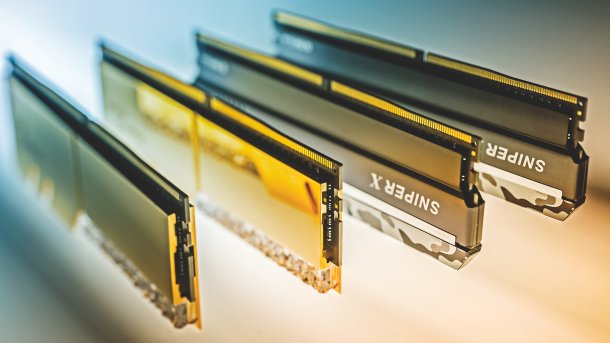8 GByte in the basic configuration: Did Tim Cook slow down Mac RAM growth?
Until 2011, Apple regularly increased the RAM configuration of its base Macs. Under Steve Jobs' successor, there was less progress.

RAM modules for PCs: They are no longer interchangeable on the Mac.
(Bild: c't)
If you take a look at Apple's current Mac range, you will notice that every basic model - with the exception of the 16-inch MacBook Pro, Mac Studio and Mac Pro - has 8 GB of RAM. That in itself sounds a little small. However, this fact has not changed since 2017 and, what makes it even more annoying, an upgrade of the main memory is no longer even planned for Apple's Mac Pro workstation. Apple's RAM shortage has just been discussed once again in the popular ATP podcast - with reference to interesting charts published by David Schaub on Mastodon in the spring.
Logarithmically rising becomes flat
A correlation was drawn between Tim Cook's start as Apple CEO in 2011 and the low to non-existent RAM increase in the Mac. Before Cook, Apple had regularly donated more RAM for the entry-level models over a period of 27 years – from 1986 to 1990, even with falling entry-level prices. However, a logarithmically rising curve became an (almost) flat line.
Under Cook, there was only a single increase: from 4 GB from 2011 to the aforementioned 8 GB in 2017. According to Schaub, the overall increase in RAM was higher than could be expected from Moore's Law for chips. One commentator on Mastodon jokingly wrote that Cook had probably really taken Bill Gates' apocryphal 640 KByte quote to heart.
Even more disruptive with Apple Silicon
Apple has long emphasized that the memory contained in the SoC of its ARM-based Apple Silicon chips as "unified memory" can also be smaller due to the ability to quickly swap data to the SSD and write it back. However, Apple has since made the SSD of its entry-level models slower in order to save money. In addition, unified memory means that there is no longer a separate memory for the GPU cores; they use the RAM built into the SoC. However, Apple believes that 8 GB is "comparable" to 16 GB in Intel systems.
There is a further problem: it is now simply impossible to expand the main memory on modern Macs. This is a disadvantage of the unified memory strategy, as it is not possible to intervene in the SoC at a later date. Accordingly, the RAM equipment of a new Mac must be chosen carefully - and more money may have to be spent. The latter in turn pleases Apple's company coffers, and therefore certainly also CEO Tim Cook.
Empfohlener redaktioneller Inhalt
Mit Ihrer Zustimmmung wird hier ein externer Preisvergleich (heise Preisvergleich) geladen.
Ich bin damit einverstanden, dass mir externe Inhalte angezeigt werden. Damit können personenbezogene Daten an Drittplattformen (heise Preisvergleich) übermittelt werden. Mehr dazu in unserer Datenschutzerklärung.
(bsc)